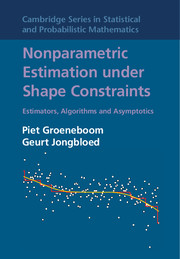Book contents
- Frontmatter
- Contents
- Preface and Acknowledgments
- 1 Introduction
- 2 Basic Estimation Problems with Monotonicity Constraints
- 3 Asymptotic Theory for the Basic Monotone Problems
- 4 Other Univariate Problems Involving Monotonicity Constraints
- 5 Higher Dimensional Problems
- 6 Lower Bounds on Estimation Rates
- 7 Algorithms and Computation
- 8 Shape and Smoothness
- 9 Testing and Confidence Intervals
- 10 Asymptotic Theory of Smooth Functionals
- 11 Pointwise Asymptotic Distribution Theory for Univariate Problems
- 12 Pointwise Asymptotic Distribution Theory for Multivariate Problems
- 13 Asymptotic Distribution of Global Deviations
- References
- Author Index
- Subject Index
8 - Shape and Smoothness
Published online by Cambridge University Press: 18 December 2014
- Frontmatter
- Contents
- Preface and Acknowledgments
- 1 Introduction
- 2 Basic Estimation Problems with Monotonicity Constraints
- 3 Asymptotic Theory for the Basic Monotone Problems
- 4 Other Univariate Problems Involving Monotonicity Constraints
- 5 Higher Dimensional Problems
- 6 Lower Bounds on Estimation Rates
- 7 Algorithms and Computation
- 8 Shape and Smoothness
- 9 Testing and Confidence Intervals
- 10 Asymptotic Theory of Smooth Functionals
- 11 Pointwise Asymptotic Distribution Theory for Univariate Problems
- 12 Pointwise Asymptotic Distribution Theory for Multivariate Problems
- 13 Asymptotic Distribution of Global Deviations
- References
- Author Index
- Subject Index
Summary
As seen in the examples discussed so far, shape-restricted estimators often satisfy the required shape constraint with minimal smoothness properties. The Grenander density estimator is decreasing, but discontinuous (see Figure 2.4). The least squares estimator for a convex decreasing density is convex and decreasing, but its derivative is discontinuous (see Figure 4.9). Similar observations can be made for other models. Sometimes, there are reasons to assume that an underlying distribution function is smooth. In other situations (as will be encountered in Chapter 9), smoothness of an estimated model is needed in a proof that a bootstrap method works.
In this chapter, the problem of estimating a smooth shape-constrained function is considered. The estimation of smooth functions without shape constraints has received quite some attention since the 1950s. Methods such as kernel smoothing and spline fitting have been widely applied and studied thoroughly. In order to obtain smooth shape-constrained estimators, various approaches are possible. A first is to smooth the nonsmooth shape-constrained estimator. In Section 8.1 this approach is illustrated using the maximum likelihood estimator (MLE) in the current status model. A related method interchanges the order of smoothing and maximizing in this procedure. In Section 8.2 it is first illustrated using the problem of estimating a decreasing density on [0, ∞) as introduced in Section 2.2. Instead of using the empirical distribution function in the definition of the log likelihood, a smooth estimator for the observation distribution function is used and then the corresponding smoothed (log) likelihood maximized to obtain an estimator. This method is also very natural if only binned observations are available. This will be seen in the context of Wicksell's problem as introduced in Section 4.1. Another method is to first estimate the distribution without using the shape constraint and process this estimator in such a way that it satisfies the shape constraint without losing its smoothness.
- Type
- Chapter
- Information
- Nonparametric Estimation under Shape ConstraintsEstimators, Algorithms and Asymptotics, pp. 197 - 225Publisher: Cambridge University PressPrint publication year: 2014



